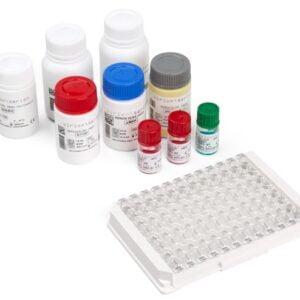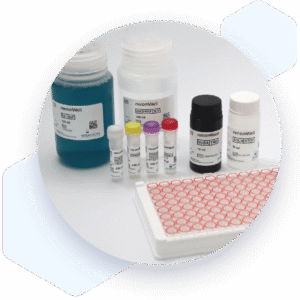| Weight | 1 lbs |
|---|---|
| Dimensions | 9 × 5 × 2 in |
| target | West Nile Virus reactive IgM |
| species reactivity | West Nile Virus |
| applications | ELISA |
| assay type | Indirect & quantitative |
| available sizes | 96 tests |
West Nile Virus IgM ELISA Kit ESR141M
$364.00
RF-Absorbent Z200 for use with IgM ELISA kits
Did you know that RF Absorbent Z200 is recommended for the removal of IgM rheumatoid factors from serum and plasma samples prior to the detection of pathogen-specific IgM? Consider adding it to your cart for improved signal specificity. For more details, please refer to the IgM ELISA kit protocol.
- Virion/Serion Diagnostic Kit for research use (RUO)
- West Nile Virus IgM ELISA Kit
- Suitable for IgM detection
- Ready-to-use
- 96 tests
West Nile Virus IgM ELISA Kit ESR141M
| kit | ||||||||||||||||||
|---|---|---|---|---|---|---|---|---|---|---|---|---|---|---|---|---|---|---|
| Assay type Indirect ELISA | ||||||||||||||||||
| Research area Infectious Disease | ||||||||||||||||||
| Sample type Serum, plasma, whole blood | ||||||||||||||||||
| Notes Pretreatment of samples with RF-Absorbent (Z200) is recommended for use with IgM ELISA kits to eliminate presence of sample rheumatoid factors and possible false negative results. | ||||||||||||||||||
Components
| ||||||||||||||||||
| Storage Store at 2-8°C. | ||||||||||||||||||
| Associated products West Nile Virus Human IgG Assay Control (BC141G) West Nile Virus Human IgM Assay Control (BC141M) West Nile Virus IgG ELISA Kit (ESR141G) West Nile Virus IgM ELISA Kit (ESR141M) |
| target relevance |
|---|
| Organism West Nile Virus |
| Protein names West Nile Virus |
| Structure and strains West Nile virus (WNV) is a single-stranded RNA virus that causes West Nile fever. It is a member of the family Flaviviridae, from the genus Flavivirus, which also contains the Zika virus, dengue virus, and yellow fever virus. The virus is primarily transmitted by mosquitoes, mostly species of Culex. The primary hosts of WNV are birds, so that the virus remains within a "bird mosquito bird" transmission cycle. The virus is genetically related to the Japanese encephalitis family of viruses. Humans and horses both exhibit disease symptoms from the virus, and symptoms rarely occur in other animals. |
| Detection and diagnosis Due to the short viraemic phase, direct detection of the virus by RT-PCR, antigen detection and cultivation frequently remain unsuccessful. Thus, the serological analysis of IgM and IgG antibodies is recommended for laboratory confirmation of West Nile Virus infections. IgM antibodies occur by the end of the first week after the onset of symptoms and are generated by more than 90% of all infected persons. IgM antibodies can be detected for several weeks or month. IgG antibodies appear not before eight days after disease onset and can persist for months or even lifelong. |
Data
Publications
| pmid | title | authors | citation |
|---|---|---|---|
| We haven't added any publications to our database yet. | |||
Protocols
| relevant to this product |
|---|
| ESR141M protocol |
Documents
| # | ||
|---|---|---|
| Please enter your product and batch number here to retrieve product datasheet, SDS, and QC information. | ||
Only logged in customers who have purchased this product may leave a review.



Reviews
There are no reviews yet.